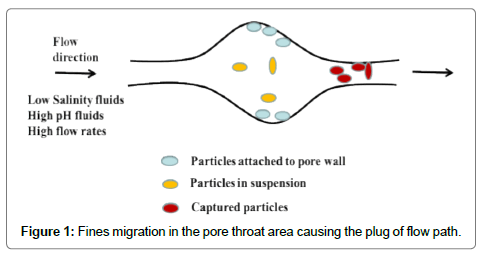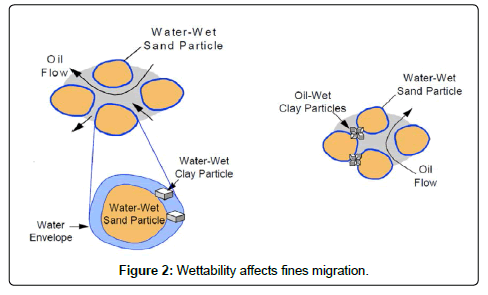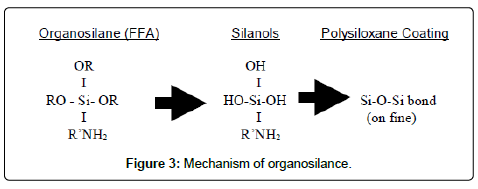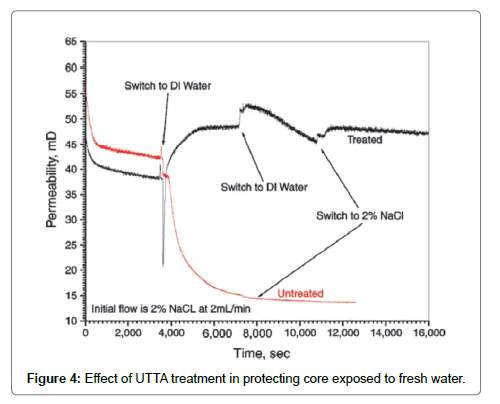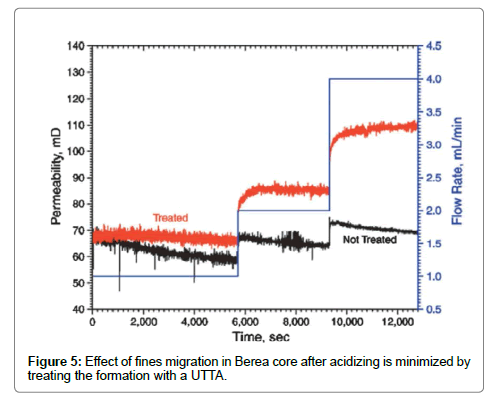Research Article Open Access
Fines Migration: Problems and Treatments
Jie Xiao*, Jianghong Wang and Xin SunHolding Energy Petroleum Engineering, (BeiJing) Co. Ltd., China
- *Corresponding Author:
- Jie Xiao
Consultant, Holding Energy Petroleum Engineering
(BeiJing) Co., Ltd, China
Tel: + 010-88593266-817
E-mail: info@smartpetrochem.com
Received Date: December 16, 2016; Accepted Date: December 22, 2016; Published Date: January 02, 2017
Citation: Xiao J, Wang J, Sun X (2017) Fines Migration: Problems and Treatments. Oil Gas Res 3: 123. doi: 10.4172/2472-0518.1000123
Copyright: © 2016 Xiao J, et al. This is an open-access article distributed under the terms of the Creative Commons Attribution License, which permits unrestricted use, distribution, and reproduction in any medium, provided the original author and source are credited.
Visit for more related articles at Oil & Gas Research
Abstract
Fines migration can cause severe damage to formation permeability and can plug the formation under certain circumstances. To effectively address this address, the mechanisms of fines migration and factors that causing fines migration were analyzed in this study. Different treatment techniques were discussed in this paper and the newly application of UTTA has been very successful in most formation types. The films it forms can enhance the ability of formation to withstand high shear stress and high flow rate. Lab core flow tests demonstrated this positive effects and it can greatly minimize the side effect of acidizing treatments, as a post-treatment method.
Keywords
Fines migration; Formation damage; UTTA; Pore size
Introduction
In the pore spaces of sandstone reservoirs, the very small loose solid particles are slowly incorporated into the sand grain in a long geologic time [1]. They particles are usually called formation fines and they are mainly classified into two basic categories: clays and nonclays particles. The non-clay particles can be quartz, amorphous silica, feldspars, zeolites, carbonates, salts and micas. Additionally, those formation fines can be incorporated into formation during drilling or completion operations. They can be part of the sandstone formation by other means as well. In the realm of formation damage, fines have been widely to be considered one of the main formation damage problems. Because they are loose in nature and cannot be placed in place or be bound together with sand grains physically by cementing materials [2-5]. Under certain circumstances, those formation fines, initially located in the interior surface of formation matrix, will migrate along flowing fluids in the formation. Along the flowing path, they are easily accumulated in the restriction points of the pore throat. Upon reaching certain concentration [6], those restriction points will prevent further flowing of fluids. Severe plugging occurs and thus considerably reduces the permeability of formation permeability. In this paper, various causes of fines migration were discussed firstly and then the treatment methods of fines migration were presented. The application of newly ultra-thin trackifying agent (UTTA) was addressed in details [7-9]. UTTA was especially helpful in controlling high rate-producing or injection wells. It can also be used as a post-treatment following the application of acid fracturing or matrix acidizing. Commercial service companies have developed and applied UTTA very successfully in recent years. This paper discussed the mechanisms of UTTA and experimental data and field cases were present for better understanding [10].
Mechanisms of Fines Migration
Dynamics of fines migration can be ruled by many factors. It can be governed by mineralogy and permeability of the rock, salinity of the water (either injected or produced water), pH value, or even by the drag forces, which is a combination effect of flow velocity, turbulence and fluid viscosity [10-15]. Figure 1 shows a typical scenario of fines migration. Fines accumulated in the pore throat area and caused severe permeability damage to the formation. There are essential three steps in the process of fines migration: presence of fines in the formation, breaking mechanism to cause fines to break apart, and trapping mechanisms to hold fines in place. Trapping can occur as a result of bridging, ionic attraction, or wettability effect. To observe the problems of fines migration, various techniques can be applied, such as production curve analysis, back flow test or core flow testing to evaluate the critical velocity and water sensitivity [16,17].
Factors Causing Fines Migration
There are various factors that can cause fines migration. The main factors are high flow rate, wettability effect, ion exchange, two phase flow, and acidizing effect, etc. The following sections discussed the factors in details.
High flow rate
Specially, each formation has a unique critical flow rate when fines migration occurs. The drag force applied to a fine particle can be affected by magnitude flow rate, oil viscosity and gas turbulence. Sometimes in well production when choke size was not designed properly, sudden increase in flow rate occurred and a flow shock was applied to fine particles and the result is probably the problem of fines migration [18]. Whereas fines can also be shocked in work over operations when well is turned on and off repeatedly. Fines migration will occur as far as the flow rate is above the critical velocity, especially for the particles of kaolinite, illite or non-clay fines. Kaolinite is more easily to be mobilized because of its booklet morphology structure [19-23].
Wettability
Wettability of the formation, fluids phases, and flow rate affect the movement of particles in the pore system. Fines tend to flow depending on their wettability when water is being injected or produced [24-26]. Figure 2 shows the effect of wettability on fines migration. The left scenario shows that fines will only move with the flow of water as water-wet fines are attracted and immersed in the envelop of water. While on the right side, fully or partially oil-wet clay particles are in oil phase and tend to easily migrated with oil flow and severe formation damage can occur.
Ion exchange
Studies have shown that clay particles become unstable as a result of expansion of lattice space of a clay particle, at smaller than 20 g/l of NaCl or equivalent of interstitial fluid [27,28]. Clay particles are more easily deflocculated and dispersed at salinities of below 1.0 g/l. The negative charge nature of clay particles will attract positive ions to align them around the clay plate. Cations within clay lattice will trade places with cations in water solution. The cations in clay lattice are initially in equilibrium with those in surrounding water. As a result of salinity change, cations exchanged occur and then can cause clay particles to break apart or swell depending on the circumstances. The permeability of formation can be severely damaged as a result of salinity change. This phenomenon can be demonstrated by water shocking experiment.
Increase of pH value
Once pH value increases dramatically, it will dissolve silica cement to cause more fines and the result can be fines migration [29,30]. The sources for increase of pH value can be from injected mud filtrates, cements or work over fluids or from decrease salinity of in-situ fluids. Lab tests show that generally pH of more than 7 tends to cause fines migration while no disturbance has been observed with pH value of below 4.
Two phase flow
In the presence of two phase flow, fines tend to migrate because fines are normally water wet and water can easily carry those fines. Turbulence in multiphase flow will make this problem more severe and the critical velocity is usually small in two phase flow. All those factors will cause fines easily to migrate in two phase flow.
Matrix acidizing
Acidizing treatments can de-consolidation of the fines and the excessive dissolution of cementing materials will generate considerably amounts of fines [31]. Under some circumstances, acidizing will not increase the permeability of the formation, instead causing more damage to formation permeability as a result of fines migration. In the near wellbore zone, local wellbore collapse can occur and release of fines will cause more damage.
Treatments of Fines Migration
There are various techniques to address the problems of fines migration. Traditional means are by using retarded HF system, enlargement of pore throat, or application of organosilane additive. In recent years, the application of UTTA has been proved to be very successful in addressing fines migration problems [32].
Retarded HF systems
Under most circumstances, fines migration occurred deep in the formation and any chemical solution must be designed to be functioning retarded as far from the wellbore as possible. Over the past years, three typical retarded HF Systems have been developed [8]. They are systems using the boron ion, systems using the aluminum ion, systems using the phosphorous containing complex. All those systems will produce hydrated silica precipitation in contact with clays. The type I should not be used in the formation containing illite or K-feldspar as it has no reaction with quartz. Type III has the highest dissolving power of silica and clays among those three. It can keep dissolving products in solution without precipitation [33].
Pore throat enlargement
As has been discussion above, acidizing treatments have the negative effects of fines migration by simply dissolving cementing materials or creating more fines in the formation. In other ways, acidizing can also enlarge the size of pore throats, especially the critical pore throat size [9]. In this case, an easier flow pathway is created and it is easier for fines to exit out of the formation. Studies show that fines will not bridge near the pore throat if the average pore size of the formation is greater than the critical range (1/7 to 1/3 of the size of average fine). By applying the relationship that pore diameter is equal to the square root of permeability in microns, the following Table 1 can be used to predict the size of fines that can plug the formation.
| Permeability, mD | Pore size, microns | Plugging range, microns |
|---|---|---|
| 100 | 10 | 1.4 to 3.3 |
| 250 | 15.8 | 2.2 to 5.2 |
| 500 | 22.4 | 3.2 to 7.4 |
| 750 | 27.4 | 3.9 to 9.1 |
| 1000 | 31.6 | 4.5 to 10.5 |
| 1500 | 38.7 | 5.5 to 12.9 |
| 2000 | 44.7 | 6.3 to 14.9 |
Table 1: Relationship between permeability, pore size and plugging range.
Organosilane
The mechanism of orgnosilane to control the problems of fines migration is to locks fines in place through a thin coating. It will form silnols in-situ on siliceous mineral surfaces through a condensation/ polymerization process (Figure 3). The coating can stabilize fines and block ion-exchange sites. Therefore, the severity of fines migration is greatly reduced [11-13].
UTTA
UTTA is firstly applied in fracturing or gravel packing operations. It is used as typical post-treatment following matrix acidizing or acid fracturing treatments [12,33]. The main objective is to demobilize fines so that fines will not migrate with the flowing fluids. Thus it reduces the problems of permeability damage. The mechanism of UTTA is to form a thin film on the formation surfaces that can encapsulate the fines. In the formation, capillary pressure helps pull the tackifier into the contact points. UTTA is applicable in most formations, for example, sandstone reservoirs, carbonates, and coals. The thin film it forms can greatly enhance the ability of formation to withstand high stress in the case of high flow rates [34] (Figures 4 and 5).
Conclusions
In this study, various factors contributing to fines migration are discussed. The mechanisms and treatments of fines migration are presented. The following conclusions can be drawn from this study:
• Fines migration can severely damage the permeability of formation and should always be minimized. Any chemical treatment can potential cause fines migration and should be evaluated in the lab prior to field implementation.
• The newly application of UTTA in controlling fines migration has been very successful because it can be applied in most formations and the thin film it formed can greatly enhance the ability of formation to withstand high flow rate.
References
- Al-Dahlan MN, Nasr-El-Din HA, Al-Qahtani AA (2001) Evaluation of Retarded Hf Acid Systems Society of Petroleum Engineers SPE International Symposium on Oilfield Chemistry, Houston Texas.
- Bedrikovetsky PG, Siqueira FD, Furtado CJA (2010) Quantitative Theory for Fines Migration and Formation Damage SPE International Symposium and Exhibition on Formation Damage, February Lafayette Louisiana USA.
- Coholan PD, Feeney J, Anderson SP (2008) Life and Times of Eddy Zorro: A Review of the Gulf of Mexico Loop Current Activity Offshore Technology. Conference 5-8 May Houston Texas USA
- Elhady AA (2005) Operating Experiences of Deg and Meg for Hydrate and Dew Point Control in Gas Production Offshore Mediterranean International Petroleum Technology, Doha Qatar.
- He J (2011) Calcium Sulfate Formation and Mitigation When Seawater Was Used to Prepare Hcl-Based Acids Texas A&M University.
- He J (2015) An Innovative Closed Fracture Acidizing Technique for Deep Carbonate Reservoirs Using Glda Texas A&M University.
- He J, Arensman D, Nasr-El-Din H (2013) Effectiveness of Calcium Sulfate Scale Inhibitors in Spent Hydrochloric Acid/Seawater System. Journal of Petroleum & Environmental Biotechnology, Vol-4.
- He J, Arensman D, Nasr-El-Din H (2013) Mitigation of Calcium Sulfate Precipitation in Spent Hydrochloric Acid/Seawater System, OTC Brasil.
- He J, Mohamed IM, Nasr HA (2011) Mixing Hydrochloric Acid and Seawater for Matrix Acidizing: Is It a Good Practice? In SPE European Formation Damage Conference: Society of Petroleum Engineers.
- He J, Mohamed IM, Nasr HA (2012) Mitigation of Calcium Sulfate Scale Formation When Seawater Is Used to Prepare Hcl-Based Acids In SPE International Symposium and Exhibition on Formation Damage Control: Society of Petroleum Engineers.
- He J, Mohamed IM, Nasr HA (2013) Potential Formation Damage Due to Preparing Hcl Acids Using Seawater Canadian Energy. Technology and Innovation Journal 1: 56-63.
- He J, Nasr HA (2013) Petro chemistry and Chemical Engineering.
- Hibbeler J, Garcia T, Chavez N (2003) An Integrated Long-Term Solution for Migratory Fines Damage SPE Latin American and Caribbean Petroleum Engineering. Conference in Port-of-Spain Trinidad and Tobago
- Huang T, Crews JB, Willingham JR (2008) Using Nanoparticle Technology to Control Fine Migration SPE. Annual Technical Conference and Exhibition, Denver Colorado USA.
- Kalfayan LJ, Watkins DR (1990) A New Method for Stabilizing Fines and Controlling Dissolution During Sandstone. Acidizing SPE California Regional Meeting , Ventura California.
- Kumar R, He J, Nasr HA (2014) New Insights on the Effect of Oil Saturation on the Optimum Acid Injection Rate in Carbonate. Acidizing In SPE Improved Oil Recovery Symposium: Society of Petroleum Engineers.
- Kumar RP, He J, Nasr HA (2014) Effect of Oil Saturation on Acid Propagation During Matrix Acidulation of Carbonate Rocks. In SPE Latin America and Caribbean Petroleum Engineering Conference: Society of Petroleum Engineers.
- Liu X, Civan F (1995) Formation Damage by Fines Migration Including Effects of Filter Cake Pore Compressibility and Non-Darcy Flow - a Modeling Approach to Scaling from Core to Field Society of Petroleum Engineers. SPE International Symposium on Oilfield Chemistry, San Antonio Texas.
- Mohamed I, He J, Nasr HA (2013) Effect of Brine Composition on CO2/Limestone Rock Interactions during CO2 Sequestration. Journal of Petroleum Science Research 2: 14-26.
- Mohamed IM, He J, Mahmoud M (2010) Effects of Pressure CO2 Volume and the CO2 to Water Volumetric Ratio on Permeability Change During CO2 Sequestration. Abu Dhabi International Petroleum Exhibition and Conference: Society of Petroleum Engineers.
- Mohamed IM, He J, Nasr HA (2011) Carbon Dioxide Sequestration in Dolomite Rock in International Petroleum Technology Conference: International Petroleum Technology Conference.
- Mohamed IM, He J, Nasr HA (2011) Permeability Change During CO2 Injection in Carbonate Aquifers: Experimental Study in SPE. Americas E&P Health Safety Security and Environmental Conference: Society of Petroleum Engineers.
- Mohamed IM, He J, Nasr HA (2011) Permeability Change during CO2 Injection in Carbonate Rock: A Core flood Study in SPE Production and Operations Symposium: Society of Petroleum Engineers.
- Mohamed IM, He J, Nasr HA (2011) Sulfate Precipitation During CO2 Sequestration in Carbonate Rock in SPE Project and Facilities Challenges. Conference at METS: Society of Petroleum Engineers.
- Mohamed IM, He J, Nasr HA (2012) Carbon Dioxide Sequestration in Sandstone Aquifers: How Does It Affect the Permeability? In Carbon Management Technology Conference: Carbon Management Technology Conference.
- Mohamed IM, He J, Nasr HA (2013) Experimental Analysis of CO2 Injection on Permeability of Vuggy Carbonate Aquifers. Journal of Energy Resources Technology 135: 13-301.
- Mohamed IM, He J, Nasr HA (2012) Permeability Reduction during CO2 Injection in Sandstone Aquifers: Lab and Simulation Studies Canadian Energy. Technology and Innovation Journal 1: 36-44.
- Nasr HA, Mahmoud M, Wolf CA (2012) Process to Fracture a Subterranean Formation Using a Chelating Agent, In USA Patent.
- Nguyen PD, Weaver JD, Rickman RD (2005) Controlling Formation Fines at Their Sources to Maintain Well Productivity. SPE International Improved Oil Recovery Conference in Asia Pacific Kuala Lumpur, Malaysia.
- Ohen HA, Civan F (1991) Predicting Skin Effects Due to Formation Damage by Fines Migration. SPE Production Operations Symposium Oklahoma City, Oklahoma.
- Wennberg KE, Batrouni G, Hansen A (2000) Modeling Fines Mobilization Migration and Clogging. sixteenth World Petroleum Congress Calgary, Canada.
- Xuejun H, He J, Tenfei S (2015) Analysis of the Critical Buckling Loads and Contact Loads on Coiled Tubing String in a Vertical Micro hole. Chemistry and Technology of Fuels and Oils Journal 51: 308-319.
- Xuejun H, He J, Tenfei S (2015b) Analysis on Design of Coiled Tubing Sliding Drilling Electronic Control Tractor with Hydraulic-Driven in Micro hole. Electronic Journal of Geotechnical Engineering 20: 4333-4347.
- Yan J, Wang H, He J, Huang X (2009) Fracturing string packer packer Comparison Analysis Well Testing 18: 6-11.
Relevant Topics
Recommended Journals
- Oil & Gas Research Journal
- Renewable Energy and Applications Journal
- Oceanography Journal
- Industrial Pollution Control Journal
- Coastal Zone Management Journal
- Climatology & Weather Forecasting Journal
- Geoinformatics & Geostatistics Journal
- Engineering and Technology Journal
- Petroleum & Environmental Biotechnology Journal
- Polymer Sciences Journal
Article Tools
Article Usage
- Total views: 9846
- [From(publication date):
March-2017 - Jul 14, 2025] - Breakdown by view type
- HTML page views : 8503
- PDF downloads : 1343

